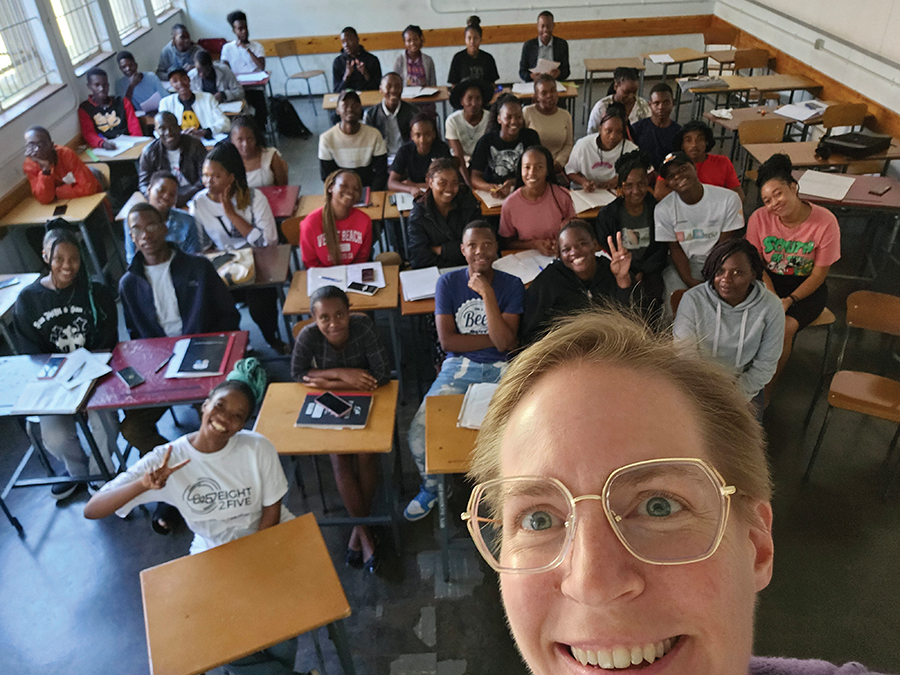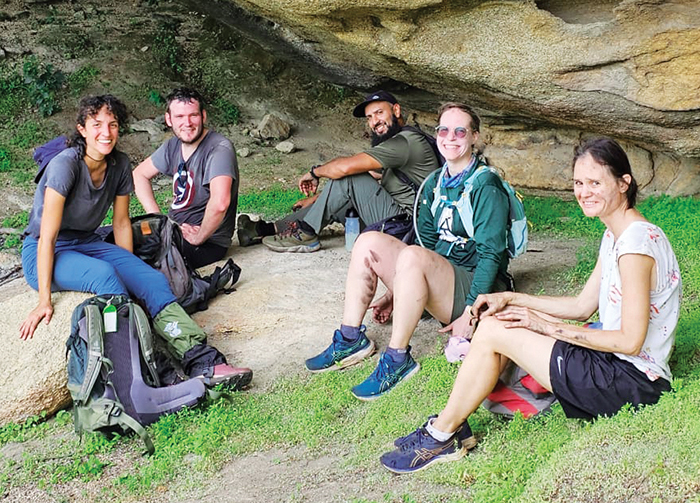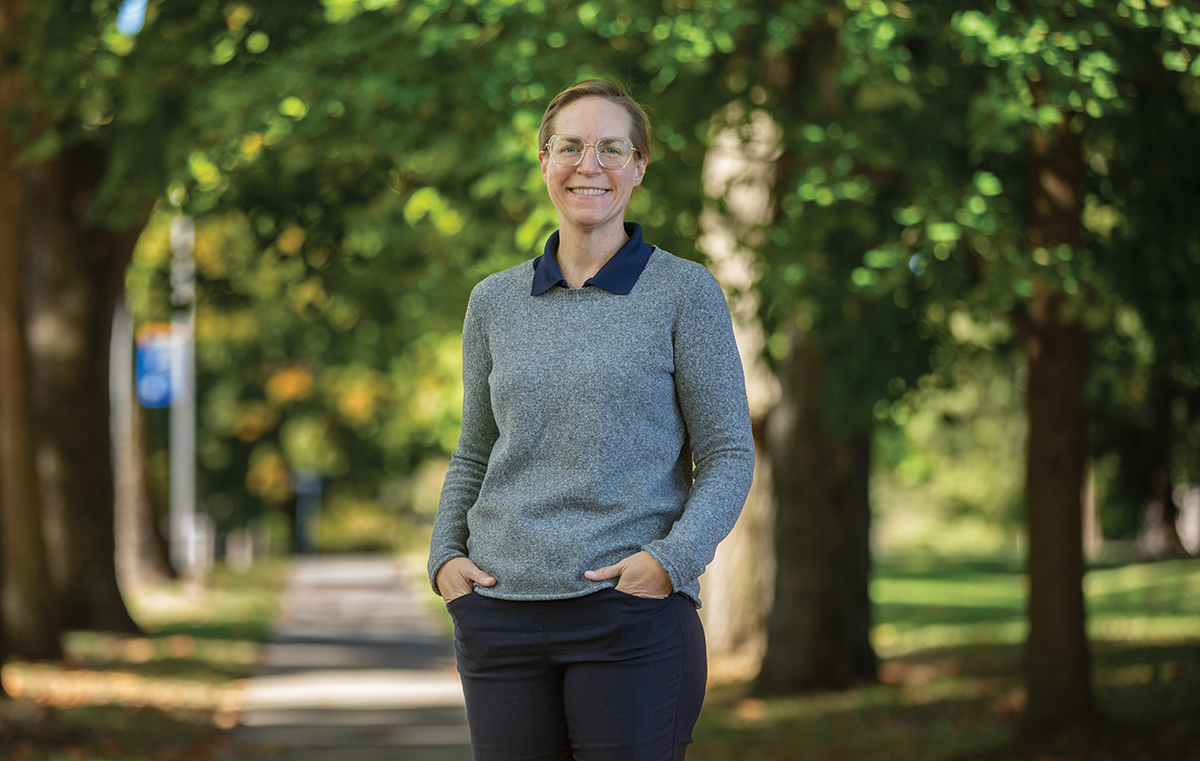In the Spotlight: Kristin Kuter
By Ashley Chaveriat ’25
What was your route to Saint Mary’s?
I actually was born in South Bend; my mom attended elementary school at Havican Hall (now the Early Childhood Development Center) and worked as a pharmacist at the Sisters of the Holy Cross Convent. At Saint Mary’s, there was a community garden space and my mom had a plot, so I remember being at the Convent and the garden. I have lots of family connections to Notre Dame, but my siblings and I all went to University of Wisconsin Madison after moving there when I was 10. I did my undergraduate studies there, then my masters and PhD at the University of California, San Diego. I really wanted to stay on the West Coast, but then the posting at Saint Mary’s popped up. They were hiring for a position in statistics and actuarial math, and my research is in probability with applications of financial math. While I have been here for 15 years now, I still have moments when I drive around a corner, and all these childhood memories of running around the Convent and garden flash back.
What do students take away from a course with you?
I teach primarily Probability and Statistics, and we have the Masters in Data Science, so my classes are related to getting information out of data. I hope students have two outcomes. The first is academic: understanding content, problem-solving, and critical thinking regarding knowing facts and truth, especially with regard to AI and navigating the current landscape. The second outcome: I want them to know that I see them as whole people; that they have other things in their life, and I’m here as support or a resource. There’s a mathematician whose quote always spoke to me. It’s about thinking of students as not only students but as partners. I value the students and our connections.
What is your classroom dynamic?
I discovered this approach rather recently—I went to a workshop about an “inquiry-based learning” approach for teaching mathematics, which places more emphasis on engaging students actively. I have always wanted to do this. The goal is to set up a series of activities and questions to guide the learner to the knowledge. I found this works really well in my statistics course for math majors, where I have added computational labs, since statistics is a science. I provide guidance for all students, especially first-years, to whom I give space to try things out. I want my students to practice presenting, be comfortable taking risks, and understand that mistakes happen. Creating a space conducive for learning and student growth is important.

statistics and statistical modeling at the Harare Institute
of Technology.
What has been a highlight of your teaching career?
If I had to pick one, it would be related to the Masters in Data Science program. I was part of the team that developed and launched the program and became its first director. A student named Masa Gumiro ’18—who chose Saint Mary’s because of our curriculum, connection to the Congregation of the Holy Cross, and the 1:1 attention we give our students—was working on his practicum project. His project helped identify solutions for a delivery company in his native Zimbabwe. Because roads there weren’t maintained well and created a lot of flat tires, Masa built a diagnostic device to put on the wheels to monitor tire pressure. It was an amazing project that met a real need. He entered his device in the National Professional STEM Masters Association’s competition for a student practicum project and won! Because of his work, I targeted Zimbabwe for my Fulbright Fellowship and got to meet his family and visit his hometown. While I was there, I taught applied statistics to undergraduates at the Harare Institute of Technology, and statistical models to financial engineering students. I mentored students and faculty in any way that I could.
How can our undergraduate students stand out?
Math is still a male-dominated field. There is an awesome conference in Nebraska called the Undergraduate Conference for Women in Mathematics that focuses on community and support, especially for women. I have taken students a number of times and encouraged them to present, whether it is a talk or a poster because students need that practice. Doing it at this conference is such a nice first experience. It emboldens them with confidence and experience, whether they are in their courses or careers, giving reports to supervisors, and even talking to CEOs. I love mentoring students and sharing my experiences as a woman in STEM. I had a bit of impostor syndrome starting out, but I had great advisors at UW Madison who reassured me and pushed me.
"I want my students to practice presenting, be comfortable taking risks, and understand that mistakes happen. Creating a space conducive for learning and student growth is important"
- Kristin Kuter, PhD

What keeps you energized outside of the classroom?
Running, hiking, and being outside! I went to grad school in San Diego and fell in love with hiking and backpacking. Part of my sabbatical last year was hiking the Pacific Crest Trail. I did 1,000 miles in three months! I need that extreme connection to the outdoors and wilderness. Every summer, I try to get in a big backpacking trip. I started running during COVID. I have run marathons in Alaska and ultra-marathons on trails. My most recent goal was to run a 50-mile race in 12 hours. On October 12th, I did it, completing the race in 12 hours and two seconds!
Future you, what’s she working on?
Hopefully get a National Science Foundation grant to support international research experiences for undergraduate students. We are looking to get funding to take students to Sri Lanka. I love exploring different cultures, as I did when I went to Zimbabwe. I think about how valuable it was to go outside of my traditional experiences. I also hope to build more pathways and partnerships between Saint Mary’s and Notre Dame and keep growing the engineering program.

